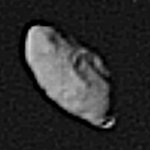Prometheus (moon)
|
|

| |
| Discovery | |
|---|---|
| Discovered by | Collins, Voyager 1 |
| Discovered in | October, 1980 |
| Orbital characteristics | |
| Semimajor axis | 139,353 km [1] (http://sse.jpl.nasa.gov/planets/profile.cfm?Object=Sat_Prometheus) |
| Eccentricity | 0.0024 |
| Orbital period | 0.614102 d |
| Inclination | 0.007° (to Saturn's equator) |
| Is a satellite of | Saturn |
| Physical characteristics | |
| Diameter | 148×100×68 km |
| Surface area | km2 |
| Mass | 3.3×1017 kg |
| Mean density | 0.63 g/cm3 |
| Surface gravity | 0.0087m/s2 |
| Rotation period | synchronous |
| Axial tilt | zero |
| Albedo | 0.6 |
| Atmosphere | none |
Prometheus (proe-mee'-thee-us, Greek Προμηθέας) is a moon of Saturn. It was discovered in 1980 from Voyager photos, and was designated 1980 S 27. In 1985 it was officially named after Prometheus, a Titan in Greek mythology. It is also designated as Saturn XVI.
This small moon is extremely elongated, measuring about 148 by 100 by 68 km. It has several ridges and valleys and a number of craters of about 20 km diameter are visible, but it is less cratered than nearby Pandora, Epimetheus and Janus. From its very low density and relatively high albedo, it seems likely that Prometheus is a very porous icy body. There is a lot of uncertainty in these values, however, and so this remains to be confirmed.
Prometheus's_effect_on_the_F_Ring.jpg
Prometheus acts as a shepherd satellite for the inner edge of Saturn's F Ring. Recent images from the Cassini probe show that Prometheus's gravitational attraction creates kinks and knots in the F Ring as the moon 'steals' material from it.
There is also an asteroid called 1809 Prometheus.
External links
- The Planetary Society: Prometheus (http://www.planetary.org/saturn/prometheus.html)
| Saturn's natural satellites |
|---|
| Janus' group | Mimas | Enceladus | Tethys | Dione | Rhea | Titan | Hyperion | Iapetus | Inuit group | Gallic group | Norse group |
es:Prometeo (luna) fr:Prométhée (lune) nl:Prometheus (maan) nn:Jupitermånen Prometheus ru:Прометей (спутник Сатурна) zh:土卫十六
